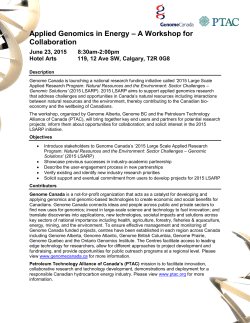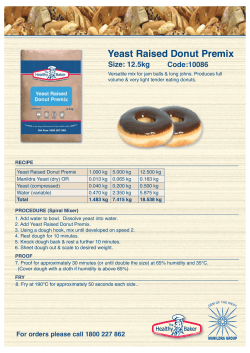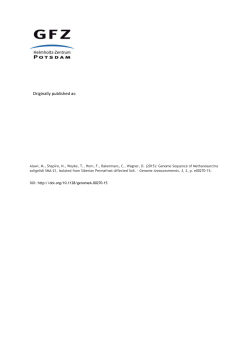
"Genome engineering through chromosome KO and BIT
"Genome engineering through chromosome KO and BIT translocation in yeast model cells: biomedical and biotechnological outcomes" By Carlo V. Bruschi and Valentina Tosato The talk will start with an overview of the model value of the yeast Saccharomyces cerevisiae in the molecular genetics field of the last years, beginning with the achievement of the sequencing of its nuclear genome by a EU consortium in 1996, the first in history for a eukaryotic cell. The most important genome manipulations achieved by the Yeast Molecular Genetics Group of ICGEB Trieste will be presented, in particular the STIK system for specific DNA integration, commercialized since several years by Open Biosystems Inc., based on FlpFRT site-specific recombination, allowing the insertion of any DNA fragment into any genome position without the requirement for a selectable element. Follows the Chromosome Knock Out (KO) technology studied and implemented on yeast euploid and aneuploid cells in which it has demonstrated the tendency to restore the number-independent euploid status and demonstrating that the cell is not capable of counting centromeres. Finally, in the second part, the most recent chromosome Bridge-Induced Translocation system, which, allowing the production of ad hoc chromosome translocation in the cell, it has been instrumental to demonstrate the temporal relationship between genetic lesion and loss of cell-cycle control typical of cancer cell. Several other genetic effects have been studied as consequent to chromosome translocation and a possible pathway for the overcoming of cancer drug resistance has been discovered. The implications of these results from a model cell system on the molecular genetics and physiology of human oncogenic transformation will be presented as well as its practical implementation in applied biotechnology projects. Carlo V. Bruschi Principal Investigator, ICGEB, Trieste, Italy Prof. Bruschi obtained his degree in Medical Biology from the University of Parma in 1976, specialized in Human Cytogenetics at the University of Rome in 1977-78 and obtained a NIH Postdoctoral Fellowship at the Biomedical Division, Lawrence Berkeley Laboratory, University of California, Berkeley, from 1981 to 1983. Afterwards, he obtained a tenure-track position at the School of Medicine of the University of North Carolina, Greenville, NC, where he was tenured and promoted to Associate Professor in 1988. The following year he returned to Italy as Senior Scientist to lead the Microbiology Group of the new International Centre for Genetic Engineering and Biotechnology (ICGEB), an international research organization initially part of UNIDO. From 1995 to 2003 he has been a P.I. and Co-P.I. on NASA Space Biology research program, performing two experiments in space, on the Space Shuttle in 1992 and 1994. He has collaborated intensively with the biotech and pharma industry conducting several applied research projects and served as Regional AREA Science Park representative for Biotechnology to the European Biopole program in 1991-92. He served as member of several European Union scientific projects like the Yeast Genome Sequencing, in FW III and IV, EUROFAN in FW IV, SABAF in Concerted Action 1994, Bacillus subtilis Genome Sequencing in Concerted Action 1996-99 and Leishmania EULEISH Genome Sequencing in Concerted Action 1999-2001. He was Scientific Director of two AREA Science Park and ICGEB spin-off companies and of an Italian National Research Project on Advanced Biotechnologies II from 1999 -2003. He is currently also a Visiting Professor of Microbiology at the School of Medicine of the University of Trieste and Visiting Professor of Genetics of the Cell Biology Department of the University of Salzburg, Austria. His major research interest is in the area of genome stability and recombination, in particular chromosome translocations. His group was the first to construct a specific chromosome KO system and a bridge-induced translocation (BIT) system in yeast. Throughout his career, both in the USA and Italy, he has secured more than 5 Million dollars in research grants and published near 80 scientific papers in international journals. He serves on the Editorial Board of several scientific journals and is an inventor on three biotechnology patents. Valentina Tosato Master Degree (MSc) in Pharmaceutical Chemistry (110/110 cum laude) with specialization in Biotechnology at the University of Trieste. International PhD in Nanobiotechnology with the grade "excellent" obtained at the University of Marburg, Germany. From October 2009 until now: Research Scientist at the Yeast Molecular Genetics Group, International Centre for Genetic Engineering and Biotechnology (ICGEB), Trieste, working on mitotic recombination, genome dynamics (in particular chromosomal translocations and aneuploidies) in the yeast Saccharomyces cerevisiae. Lecturer of Microbiology at the School of Medicine of the University of Trieste from 2009 to 2012. Guest Scientist in the Microbiology Group, ICGEB, working on a Italian National Research Project (PNR) for a new microarray detection system (DNASER) of the expression of yeast recombination genes, in collaboration with the University of Genova. Technical Manager of the EU Genomics Group within the FW IV Programme, coordinated by the Sanger Centre of Cambridge (UK) as part of the LGN (Leishmania Genome Network) Project supported by the World Health Organization (WHO), 1999-2001. From January 1997 to November 2001 Technical manager in two different spin-off biotech companies of the AREA Science Park of Trieste. Guest Scientist at ICGEB for the EU Project on Bacillus subtilis Genome Sequencing (BGS) 1996. Industrial collaborations with Prosol Spa (Bergamo), Microtec GmbH (Brixen, BZ), Crescendo Biologics Ltd (Cambridge, UK), FriulChem Spa (Milano), Pliva Pharmaceutical, (Zagreb), Croatia. 32 among papers, proceedings and books, 15 posters and oral presentations.
© Copyright 2025








